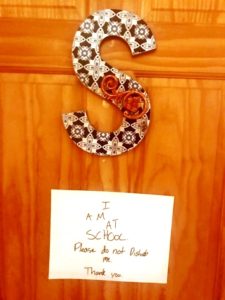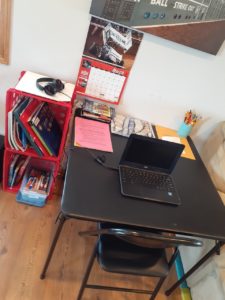by Cori Hilsgen
Due to the world-wide Covid-19 virus pandemic, Gov. Tim Walz announced on March 15 that schools would close March 18-27 for teachers and staff to develop and implement distance learning plans beginning March 30 and now extended to May 4.
Many area schools have worked hard and excelled at meeting this challenge. When teachers at the St. Joseph Catholic School learned of the school closures, they began planning.
Teachers Elisha Konz (kindergarten), Joanne Schneider (first grade), third-grade teacher Robin Kremer (third grade), Theresa Fleege (fourth grade), Tess Koltes (firth grade) and Susan Huls (sixth grade) shared some of their experiences with the distance learning.
Planning for closure
After the announcement, several teachers communicated and tested various video communication platforms.
Teachers and staff met on March 16 to plan for the school. Kremer said they were able to make good decisions quickly. Students have one-to-one devices in all grades. Kindergartners through second graders use iPads and third through sixth graders use Chromebooks. Teachers knew they would be able to send the devices home for students to use for online learning.
After preparing, Schneider said they were ready to pull together iPads, load them with the apps needed, and pull paper, pencil and hands-on activities for the students.
Konz said they are using apps they used in the classroom, as well as some new ones.
They decided they would use Google Classroom and Zoom for third through sixth graders. Google Classroom allows teachers to communicate with students, send assignments and students can also hand in assignments. They are also using Zoom to video communicate with their students in real time, together as a group.
Koltes said it was an intense first week of learning.
She said they chose Zoom because it seemed the most teacher/user friendly and they could use their Smart Boards at school to teach.
On March 16 and 17, teachers prepared lessons and organized supplies to send home while also trying to practice video conferencing using Zoom.
Kremer said they took turns being the “teacher,” so they could get a good feel for it.
St. Joseph Catholic School parents picked up supplies on March 17 and on March 18 the teachers had a test run using video conferencing with their students/parents online.
The teachers began teaching on March 19 and also created a schedule for math because some students take advanced math and move up a grade for math instruction.
While teaching online, teachers are also creating and uploading assignments.
Kindergarten through second grade
Konz said the kindergarten class meets daily for at least 30 minutes. They visit and work together during this time.
“The kindergartners have been able to successfully engage in math lessons that are presented using Smart Board Suite, toggling between our Zoom meeting room and the shortcut to our math lesson,” she said. “Our work varies day-to-day, sometimes an art demonstration or a story.”
On March 26, Konz planned to present the kindergartners with an engineering task, to build something for a bird such as a toy for our classroom pet parakeet, Lemon, or a bird shelter or feeder to use at home.
During the week they resumed their routine of “Sharing Time,” when two students each day bring something they made or found in nature to show and tell the class about, then take two questions from the audience.
“It’s like being in the classroom, you just have to tap your microphone button when you want to talk and put your hand in front of your face, so we can see that you are raising your hand,” Konz said. “The kindergartners love to be together, and they have been working hard to make our time together great for everyone. I am so grateful to be in partnership with parents that are dedicated to making online learning effective and committed to keeping their children cognitively and socially engaged.”
Schneider said it has been quite the whirlwind since the school closed to students.
“I have been teaching for 34 years, and have never been involved in anything like this,” she said.
“I am trying to limit the screen time for the children and balance it with hands-on activities and some worksheets,” Schneider said.
She teaches small groups of two to five students reading and math daily. They also gather as a class for about 45 minutes, to connect, share and listen to a story.
Schneider said story time was a favorite after lunch in her classroom and online learning has not changed that. It is still a favorite. They are using Zoom for these meetings.
“It is great to talk and be together,” she said.
“I never realized how much I feed off the enthusiasm and energy of my students,” Schneider said. “Teaching online, without them near me has been hard work. It is so much easier to teach when we are all together.”
She completed her master’s degree in learning design and technology at St. Mary’s University a few years ago and said she feels it helped prepare her for this challenge.
Principal Karl Terhaar is covering second-grade teacher Betty Pundsack’s class while she is out. He said he has been busing purchasing new iPads for the class so they could have the apps needed for distance learning. He said he is modeling his instruction after Konz.
He has also been providing goofy morning announcements “just to bring some levity to our situation” on the school’s Facebook page each day. His announcement on March 25 included a joke and discussion with a puppet, a chance to meet a foster cat his family is taking care of, a prayer for the school’s teachers who “are knocking it out of the park with what they are providing for online learning,” and reciting the Pledge of Allegiance.
The school also did the Stations of the Cross live on Facebook, so they could all pray together.
Third- through sixth-grading learning
Kremer’s third graders are meeting each day from 9:00-11:30 a.m.on Zoom. They start with prayer, share and religion each day. Then Kremer teaches phonics/spelling, reading and writing lessons. Students get a break after reading/writing class.
“They usually get a snack and stretch their legs, but they seem to come back a little early to visit with their friends before I start class again,” Kremer said.
Their math program has an on-line component, so she assigns students to complete the on-line lesson the night before. They go through their written assignment together; however students complete an exit ticket on their own to assess their understanding of the concept.
Kremer also teaches science or social studies each day.
“I have tried to keep as much the same from class as possible,” she said. The school has specialist teachers in Spanish, music, and physical education and students are also given assignments for these classes. The specialists are joining classes weekly to check in with the students.
“I have been so impressed with how well the students have adapted to their new routine and learned the necessary technology skills,” Kremer said. “I am so grateful that we are able to communicate and see each other each day. This is not only wonderful for continued academic growth but also supportive of emotional well-being. I am also grateful for companies like Zoom who have opened-up their services free-of-charge for schools.”
Fleege said that during their online learning, her class logs in with her by 8 a.m. using Zoom. They begin their day with prayer and then move into their curriculum for the day. This includes religion, grammar, vocabulary, math, reading and social. At 11:30 a.m., the students have time to eat, work on homework and go outside. At 1 p.m. they work on other subjects such as writing, spelling and art. The students end their day at 2 p.m.
“Though being on Zoom is not as powerful as having my students in the classroom, it does give us a chance to talk to each other, continue moving forward with our curriculum the best we can and for the students to ask questions and see their classmates,” Fleege said. “Many of my assignments are now on Google Classroom. This has allowed students to send me a message if they are unsure of something. This also gives me the chance to give immediate feedback.”
Koltes and Huls are trading classes. Huls teaches fifth-grade spelling/English and Koltes teaches sixth-grade writing.
Koltes said they are working hard to get this accomplished by noon each day to allow the students to complete their work in the afternoon and have their evenings free.
“I can honestly say I had a week of crash course on technology learning,” Koltes said.”It is amazing what we can all do online. Curriculum textbooks, online sites and resources and almost anything education-related has allowed free access for teachers around the United States. As a teacher, I have felt so much support in the last few days with all the unlimited resources available.”
She said the online teacher blogs she belongs to have provided many ideas and resources about what works the best for each grade level.
“The parents of my students have been supportive and receptive to what we are providing to their children,” Koltes said. “The hardest part is saying goodbye after a video meeting. It is getting easier, but the first couple of times I had to end a meeting online, the students looked sad. It was hard to say goodbye to them.”
“It has been quite a week, a crash course for many of us,” Koltes said.
Huls said she has realized how much energy her students share with her.
“At the end of a normal school day I’m pleasantly tired, used good energy, but kept having it replenished by being around the youngsters all day,” she said. “This is much more tiring than a regular school day teaching. (There is) so much more preparation ahead of time to make sure everything is ‘share-able’ on your screen, and not the same feel, (without) all the energetic, spirited bodies in the classroom.”
Huls said she is trying to be sure that the students aren’t sitting in front of a screen the whole time. This has made her realize how little she usually sits during the day when she is always moving around the room, going from class to class and up and down stairs all day. Now, she is also sitting more in front of a screen.
“Of course, we miss all the interaction and the ability to let kids work together and check their understanding by quietly leaning in and asking questions of individuals,” Huls said. “The kids are great, though. Understanding, patient with my technology flubs, still eager to be a part of sixth-grade learning and showing general good humor. (They are) still following all the rules of the classroom. I like our read-aloud book time (it) feels sort of regular.”

St. Joseph Catholic School sixth-grader Saima Velline’s bedroom door tells people when she is in-school and online learning with her teachers and other students.

One of the first tasks St. Joseph Catholic School fourth-graders were required to complete during the COVID-19 school closure was to establish a dedicated workspace. This is Easton Frieler’s workspace.




